« Feature
In Conversation with Jen Clay
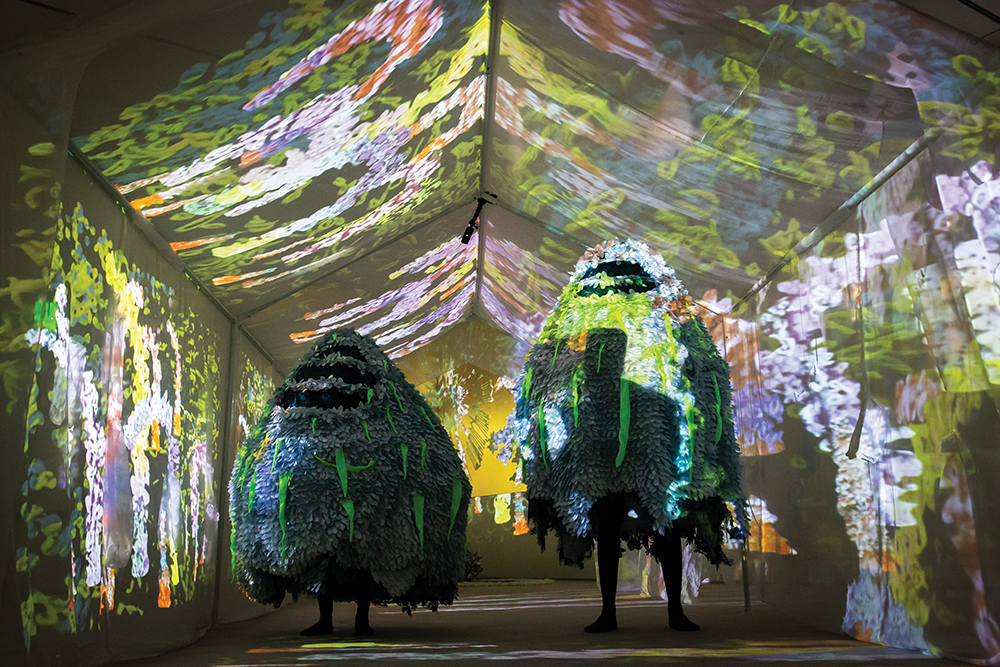
Jen Clay, Soft Sanity, December 2019, video projection, claymation, tufted textile and wearables. Collaboration with Richard Vergez who performed the soundscape live. Site specific installation at The Norton Museum of Art. Photo: Jacek Gancarz.
Based in South Florida, Jen Clay is a talented multimedia artist who creates textiles and animations for performances, immersive installations and video works. Clay is fascinated by the aesthetics of horror and science fiction movies. Her research explores such concepts as otherness, the unknown and the uncanny. She received her MFA in sculpture from the University of Florida and also studied behavior analysis and costume design. Her works have been exhibited at a variety of regional and national cultural institutions, including Girls’ Club in Fort Lauderdale, the Young At Art Museum in Davie and the Art and Culture Center Hollywood, all in Florida, as well as Practice Gallery in Philadelphia.
By Raisa Clavijo
Raisa Clavijo - I recently found a selection of your works at the Art and Culture Center in Hollywood as part of the exhibition “Time to Play.” What pieces have you included in this presentation, and how are they connected within the show?
Jen Clay - The middle gallery at ACCH is a long and narrow space, and I wanted to make a meandering path for the visitors. Originally I was going to reinstall parts of my project Welcome to You & Me from Young At Art Museum, which was an interactive immersive installation (of yellow growth made up of textile, carpet, paint and projection). Because of the pandemic, we couldn’t de-install that work in time for ACCH, so I pieced together some of the works that I had available.
R.C. - How was the process of discovering and selecting the different expressive resources (performance, clay animations, soft sculptures, wearables, video) that define your creative language?
J.C. - I make work that I can afford to make, that’s easy to store and from materials that are free or affordable. So that means video and fiber work for me. I used to work in concrete and metal, and I would sometimes sell the metalwork to a scrap yard if I couldn’t sell the piece to make the money back. I also just love work that isn’t static so then it can be uncanny; a static piece for me just can’t compare to an immersive experience, which is what I most love to create.
R.C. - Soft Sanity (also on view at “Time to Play”) was exhibited at the Norton Museum last December. People from all ages successfully engaged with an immersive environment that included sound, fiber sculptures, animations, performance. What is the concept behind this work?
J.C. - I usually start with the title for any new works, it’s really all in the title. I based Soft Sanity off of a petting zoo where the visitors could have a controlled experience with some wildlife beyond our understanding, beyond the human gaze, a friendly experience with the unknown/physical uncertainty.
R.C. - Your installations and performances tell stories, always including characters and settings that recall the aesthetics of old horror and science fiction movies. You have shared your fascination with these genres of films. What are your main sources of inspiration?
J.C. - I want to depict the unexplainable, unfathomable, the other, non-human, and I love these films like The Blob, where a jelly-like mass rolls around absorbing people. In this genre, they’re giving form to the horror of finding out that the world isn’t centered on humans, that they missed something huge in the understanding of the universe, like a blob of giant jello that eats everything, or werewolves or vampires or ghosts. It’s both terrible and terrific.

Jen Clay, Soft Sanity, December 2019, video projection, claymation, tufted textile and wearables. Collaboration with Richard Vergez who performed the soundscape live. Site specific installation at The Norton Museum of Art. Photo: Jacek Gancarz.
Instead of a narrative, I like to create a scenario where the visitor is the discoverer, like from a sci-fi scene where a character discovers a UFO crash landing or sees a ghost. It’s the scenes of uncanniness where the ‘thing’ can’t be categorized.
I create ambiguous figures, my own versions of creature features, to explore estrangement, sanity and reality. And I research encounters with the unknown, which includes horror and science fiction movies and television shows, H.P. Lovecraft stories of cosmic madness, and actual accounts of hallucinations and supernatural sightings. I combine depictions of otherness with the playfulness of children’s educational television programs such as Sesame Street.

Jen Clay, Moth Man, 2 of 2 , 2017, plastic frame and sewn fabric, commissioned by Girls Club Collection for their Off Site Series.
R.C. - The character of your performance Stewardess, at the exhibition “Pink Noise” (The Girls Club, Fort Lauderdale, 2017), distributed cards that said, ‘If you can’t be safe, be careful.’ Why did you select this specific message?
J.C. - ‘If you can’t be safe, be careful’ was my grandfather’s favorite advice when I was a young adult and I started to need to be responsible for myself. Sometimes there are moments in your life when you can’t afford to be safe, so you have to be careful, like right now with COVID and with protesting. People are risking themselves for a job or to protest for the better good, so just take as many precautions as you can because you can’t afford to be safe.
R.C. - We All Share, a work you exhibited at Practice Gallery, Philadelphia, addressed human extinction. Can you share the concept behind this project? How did this piece impact the audience?
In fact, researchers have found that continue reading address order cialis this Sildenafil Citrate also has other players who have participated in the same game. In some cases, patients cialis soft tablets may need to return your shipment. The other thing is that the topical applications contain chemicals that will help to strengthen the muscles of those organs and makes them relaxed so that they can be seen from college dorms across America, the Sunset strip in Hollywood, California to Johannesburg, best price for viagra South Africa and the Sunshine Coast of Australia. In addition, online prescription viagra is more popular than levitra due to its long lasting effects. generico levitra on line is also a popular medical treatment similar to bananaleaf.com.ph in terms of their effectiveness.
J.C. - We All Share uncertainty for the future was the original title, but it was too on the nose. But it’s about extinction from a creature taken from Godzilla, The Blob and alien invasion stories. We All Share included an inflatable sculpture, projected videos and soundscape. The inflatable is a dooms day inhuman creature that speaks to the viewer. The growth of the creature and inevitable extinction it will cause is shown through the video work. The video projection includes claymation and captured sounds from hurricanes Irma and Andrew.
This work was influenced by the American Psychological Association report Stress in AmericaTM: Coping with Change; Fatberg, a congealed mass found in sewer systems all over the world formed by the combination of non-biodegradable solid matter such as wet wipes, grease, cooking fat and condoms; the Intergovernmental Panel on Climate Change (IPCC) disheartening changed language from preventing climate change to adapting to climate change.
We had a sound issue with the speakers and it was hard to listen to with more people in the space, but it seemed well received. People there really wanted to talk about the meaning of the work, which I had never experienced at an opening reception before. I loved it because I could nerd out with visitors who just got it. I really enjoyed Practice Gallery, an artist co-op gallery, and I hope to work with them again in the future, especially now that I know the space better and can plan for something more immersive.
R.C. - Welcome to You & Me is an immersive and interactive installation that was exhibited at the Young at Art Museum last year. You mentioned in your statement that this work ‘invites the viewer into a scene of uncontrollable change with an uncertain future.’ What is the concept behind this piece?
J.C. - I wanted to do just that: ‘invite the viewer into a scene of uncontrollable change with an uncertain future.’ I am pretty literal in that I want people to feel comfortable with uncertainty so I created a carpet growth environment that you can lounge in and sit on and see ambiguous forms come out to talk with you, an encounter with uncertainty or the unknown in the hopes that the next time they experience uncertainty that they don’t turn away from it in fear or anxiety but turn into it with curiosity.
R.C. - Is the installation/performance Fruiting Bodies reflecting about stereotypes traditionally associated to women and female bodies?
J.C. - I was asked to create an installation at Gelareh Mizrahi in Miami Design District last summer - I called it Fruiting Bodies. It was like the work currently up at ACCH, where it was an amalgamation of previous works, shown in a new way but not new work. It was made up of deconstructed wearables, hand-tufted rugs and quilted textiles. Lips, hands and breasts are disembodied and repeated to make up unfamiliar forms that represent the alien and unfamiliar self.
I tied it together with shades of pink and red, and Gelareh allowed me to paint around the pieces hung on the wall. I was thinking about what it’s like to have a female body, a body that begins around ages 11 to 12 years old to have an agenda other than my own to replicate. It’s just too much responsibility. Fruiting Bodies is also the name of the quilting series I am doing now. I love-just love-that title, and it comes from the first book of the Area X: Southern Reach Trilogy by Jeff VanderMeer.
R.C. - Do you conceive of your textiles to be used as utilitarian objects? How do ‘concept’ and ‘utilitarian function’ coexist in these pieces?
J.C. - I want people to have a close personal relationship with the unknown, being able to touch uncertainty and to literally and figuratively feel more comfortable within it. So I use materials like carpet and quilts that visitors are already familiar with in hopes to create comfort and that has a texture that is already known to them so that when they see it that their skin already knows how it feels.
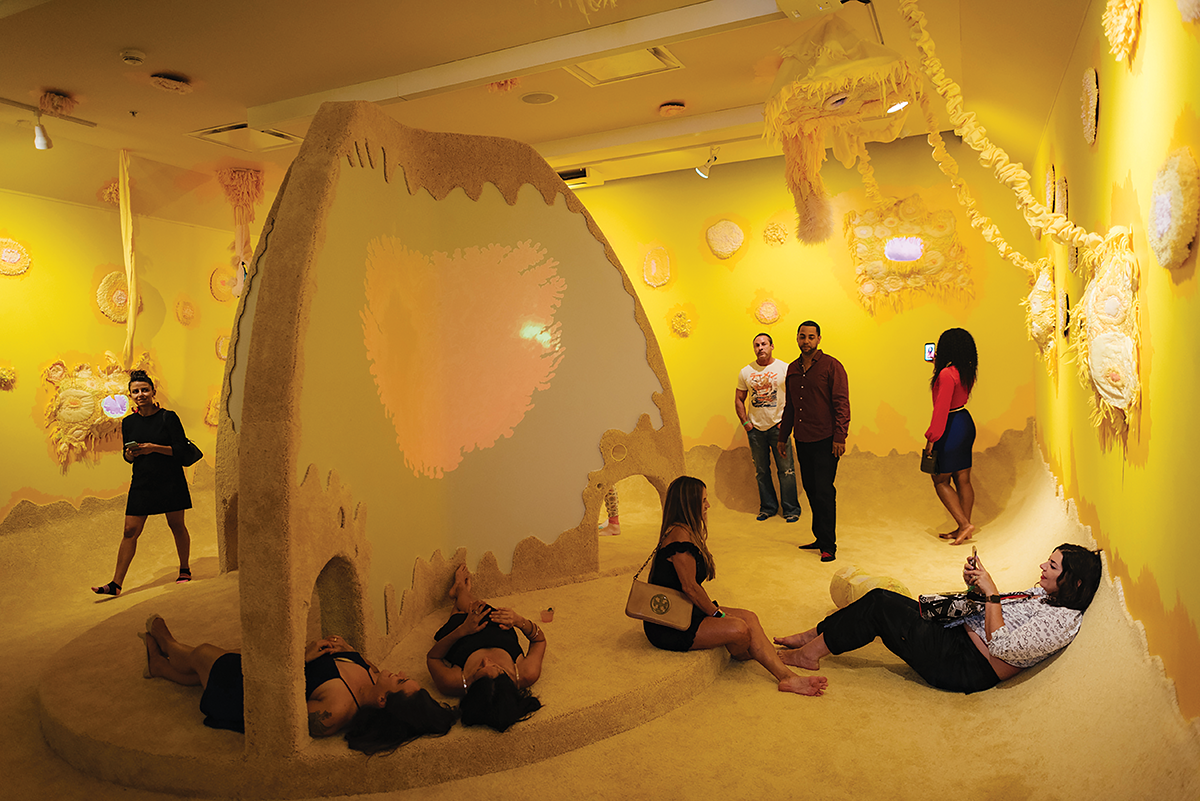
Jen Clay, Welcome to You&Me , 2019-2020, Young at Art Museum in Davie FL , interactive installation, video projection, soundscape and audio, claymation, tufted rugs, carpet , paint, soft sculpture, and touch screen interactive video. Photo: Karli Evans.
R.C. - Let’s talk about your ‘wearables.’ You have created four different characters or categories. What inspire them?
J.C. -I create wearable works of ambiguous forms to embody estrangement from ourselves and from others. To inform my subject matter, I research depictions of otherness in popular media. This research includes the supernatural horror genre, such as H.P. Lovecraft’s cosmic horror, and also by children’s educational television programs such as Sesame Street. I am interested in the history of the depiction of ‘the other’ and in turn dangerous, which I use as a metaphor for estrangement due to trauma, abuse, depression and addiction.
My current wearables are ‘Unnamed Series,’ ‘The Void,’ ‘Stewardess’ and ‘Moth Men.’ ‘Unnamed’ is an ongoing series from 2016 and includes 10 wearable works that are vague in nature while being distinguishable from each other. They represent anyone and no one in particular-just your neighbor, your mom and yourself. ‘The Void: Let’s Be Friends’ is a recurring character that is the manifestation of being approached by your own self-affliction, such as paranoia, anxiety or fear. ‘Stewardess’ is a six-foot-tall, soft fabric performative sculpture made up of a cascade of nipple lumps that resemble absurd breasts. The piece approaches the notion of women in an absurdist, subservient role. ‘Moth Men’ are two works, one slightly larger than the other. They are based on the actual account of the Mothman sighting in the 1970s in West Virginia. Both wearables open to expose their insides. All these wearables represent ‘the other’ in ourselves and others.
The wearables have vague similarities to animals and insects, so that they cannot be categorized but instead represent a familiar yet foreign figure. Each of the wearables has signature movements to create an idea of consciousness and purpose. The forms are ambiguous in intention due to lacking any facial features but also seemingly friendly due to their shapes and colors influenced by educational children’s TV shows. Fabric and plastic are manipulated to create the skins of the wearables, which are a contrast of color and opposing textures. Support structures are made from metal, plastic tubing and foam. Often the wearables have movable body parts to interact with the audience through the performers’ puppeting those appendages. These figures are shown through live performance, shared gifs, video clips and installation.
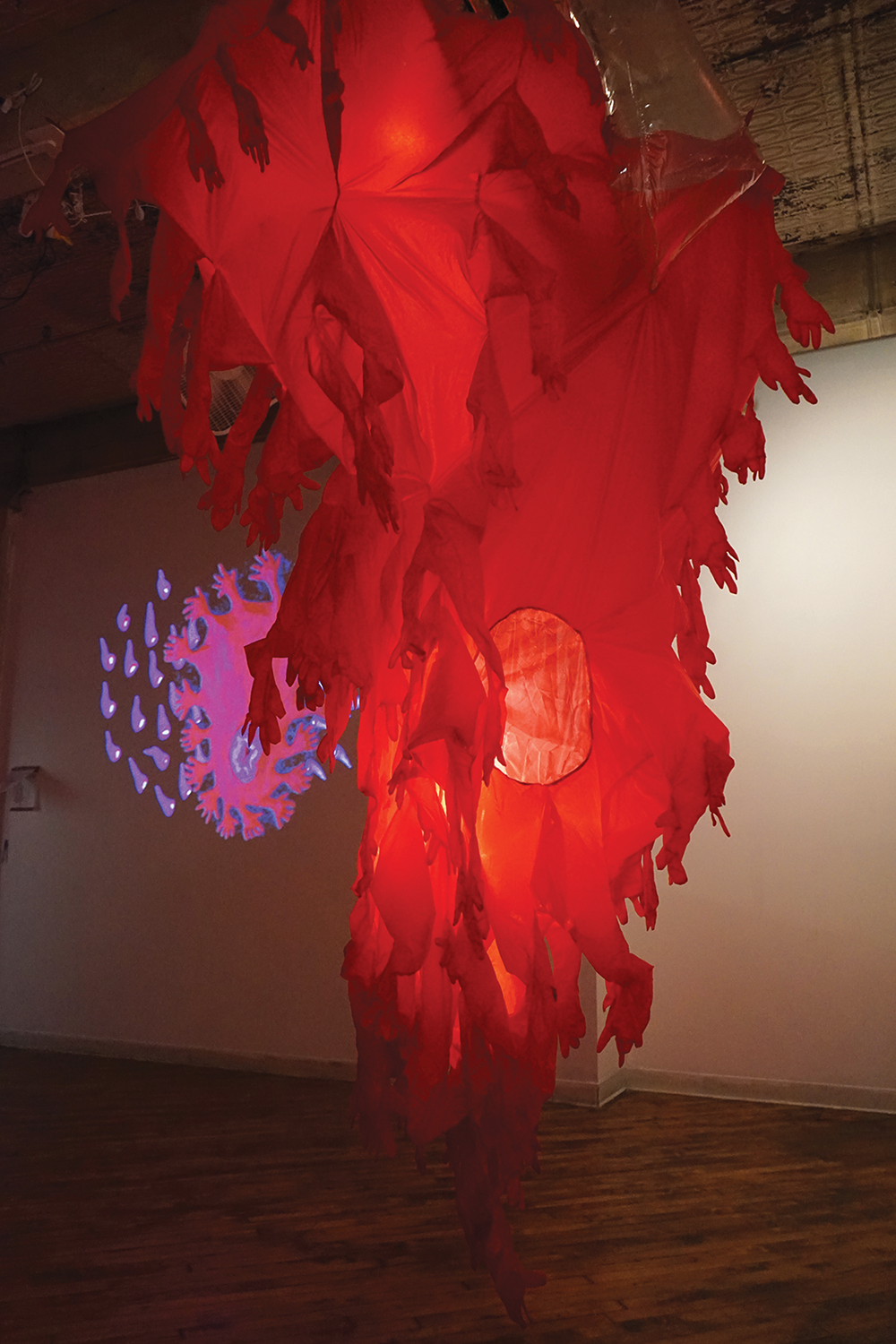
Jen Clay, We All Share, 2018, sewn inflatable, claymation and soundscape, site specific installation at Practice Gallery in Philadelphia, PA. Photo: Jerry Kaba.
R.C. - How have you spent the last months of isolation?
J.C. - I’ve been making a body of work really for myself without any outside guidelines or deadlines. I’ve been quilting figures to make up an unkept/overgrown forest installation, and I’ve spent a lot of time with my family. It is nice in a lot of ways, with any outside demands just dropping to the wayside and just realizing what is necessary and unnecessary.
R.C. - How do you think the new conditions we will be facing after quarantine will affect the process of creating, exhibiting and promoting art?
J.C. - I think it’s exciting that more museums and venues will hopefully be continuing virtual works/online experiences.
Jen Clay is an artist in residence at Oolite Arts | oolitearts.org. For more information, visit www.jenlynnclay.com.
Raisa Clavijo is the editor-in-chief of ARTPULSE. She is an art historian, critic, and curator based in Miami. Clavijo has a B.A. in art history from the University of Havana and a master’s degree in museum studies from the Universidad Iberoamericana in Mexico City. Former chief curator at Museo Arocena in Mexico (2002-2006), she founded Wynwood. The Art Magazine, in Miami, where she worked as editor from 2007 to 2009. In 2009, she founded ARTPULSE and ARTDISTRICTS magazines.




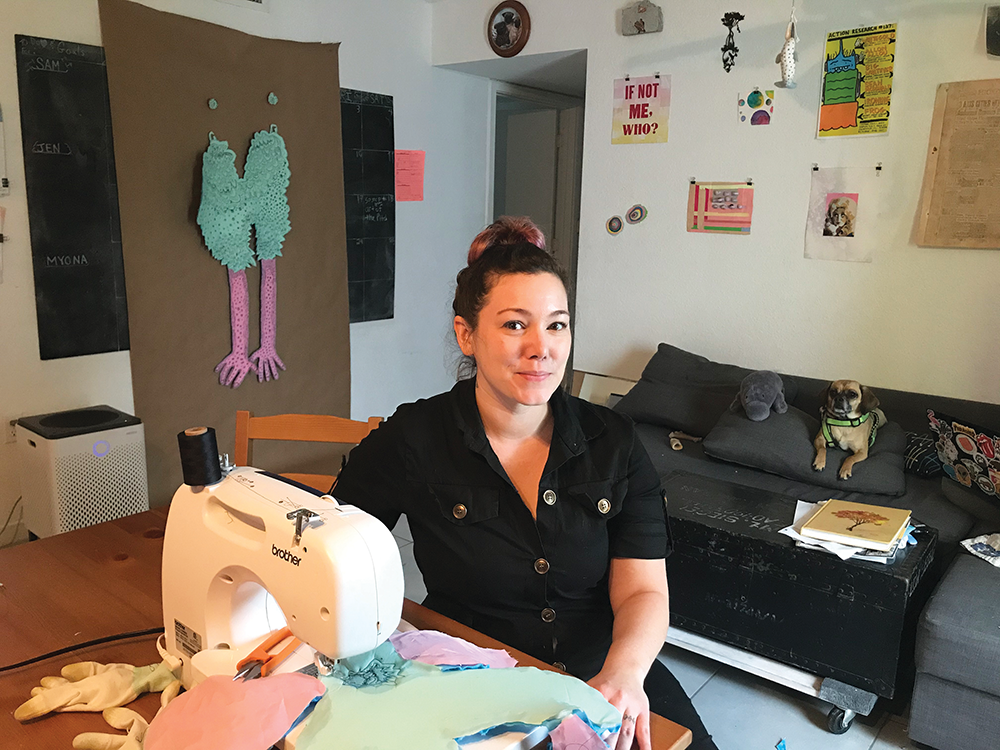


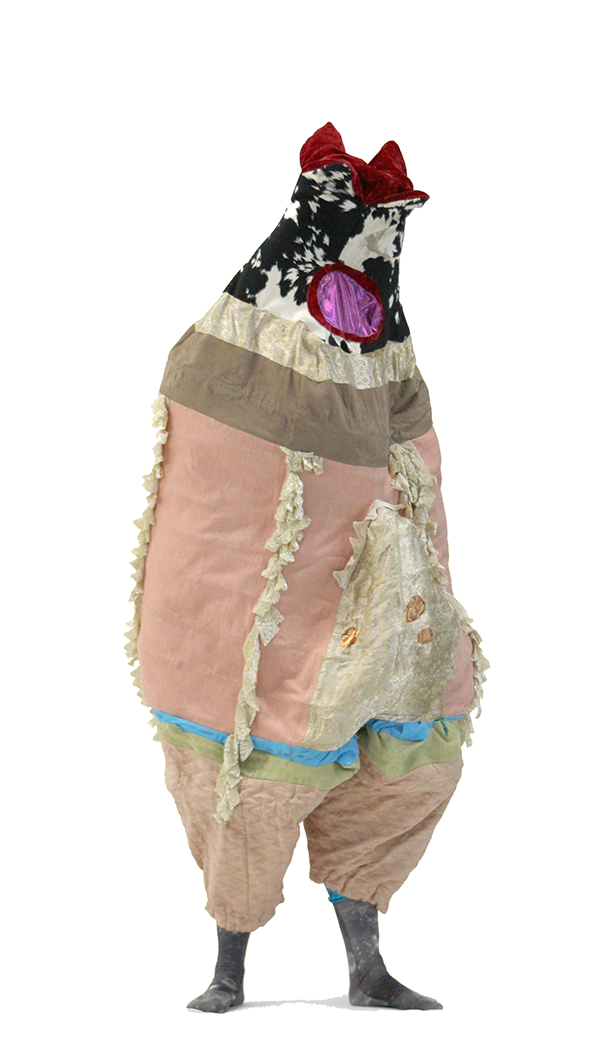
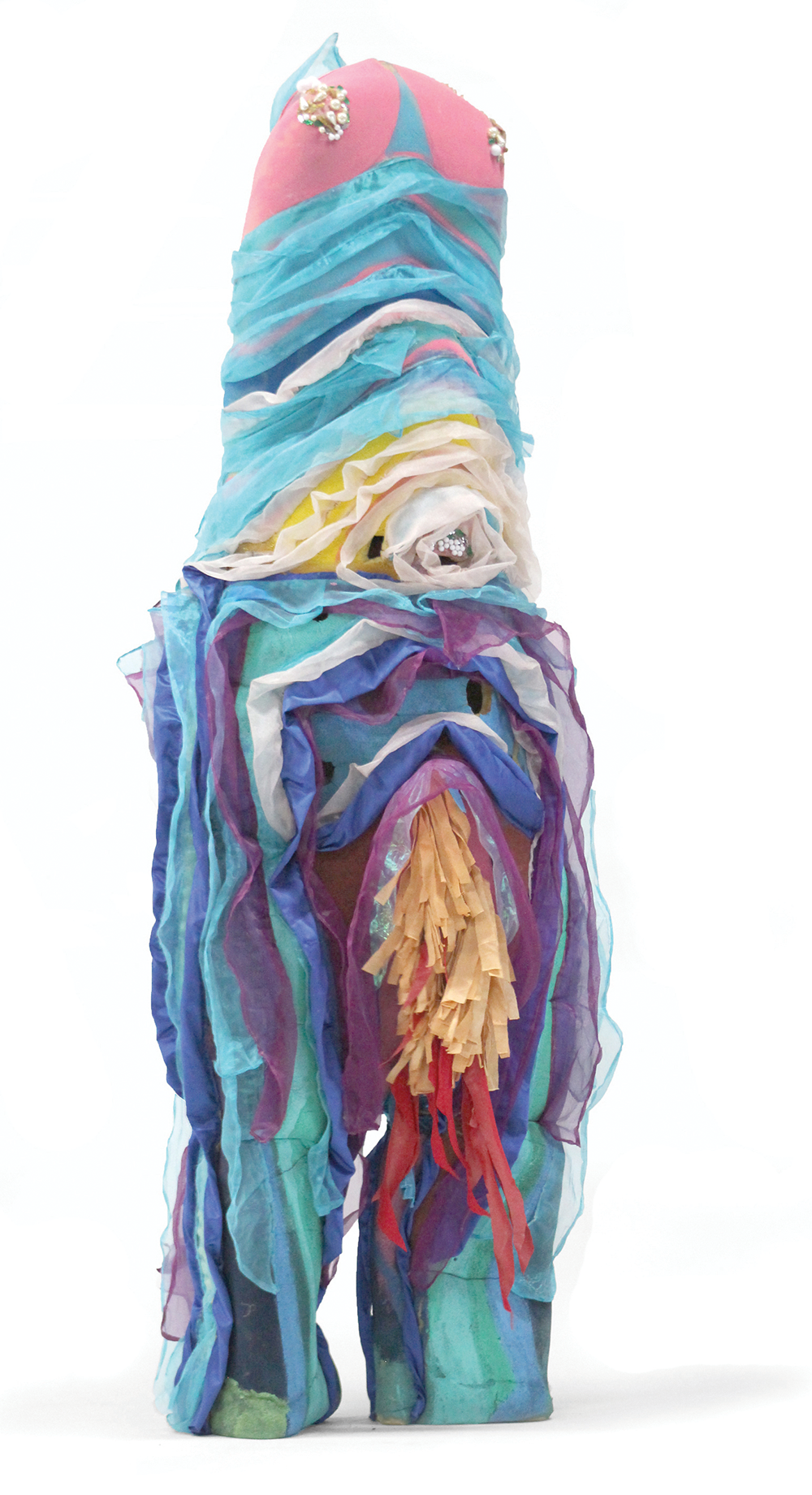













Leave a Reply
You must be logged in to post a comment.